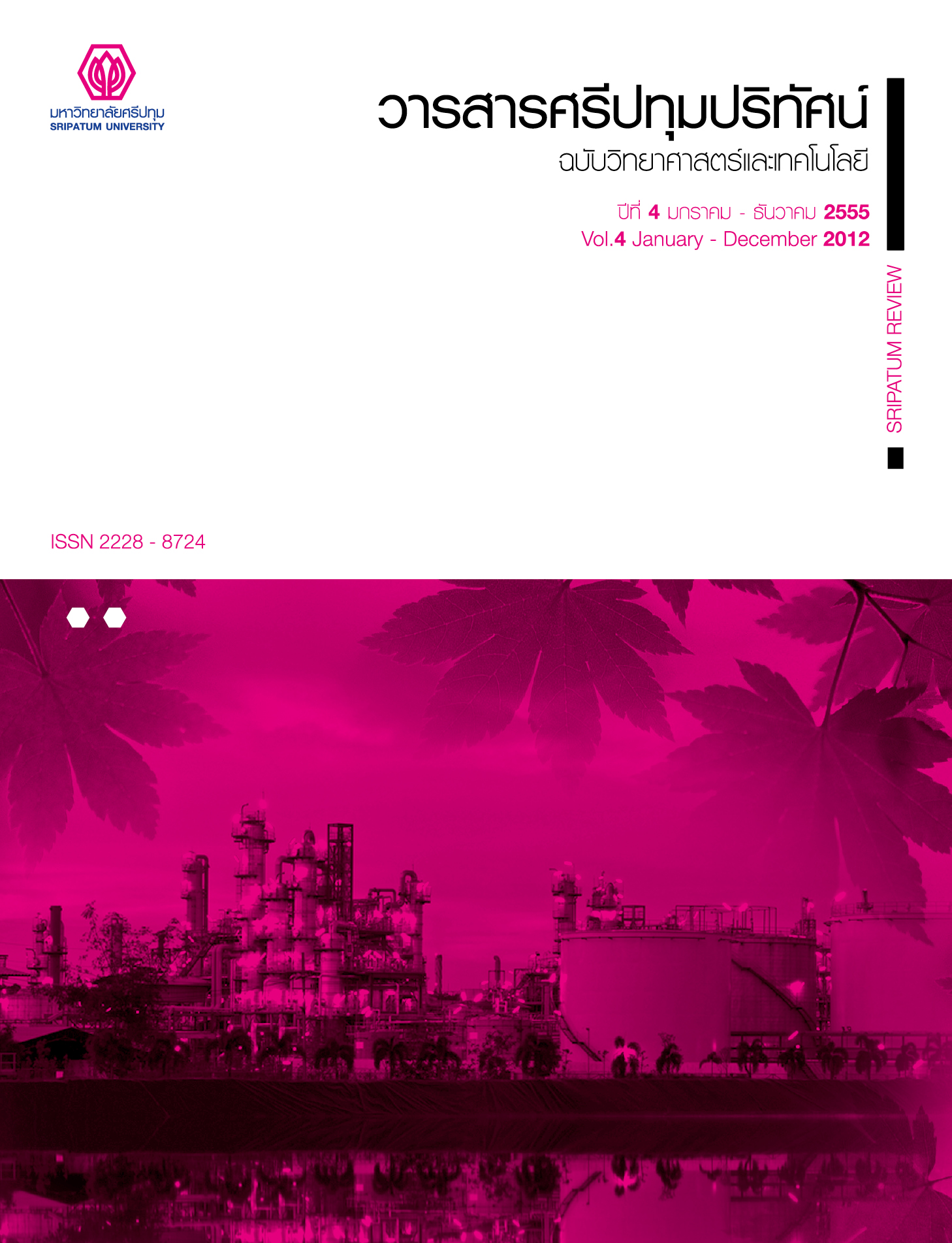การหาพารามิเตอร์ที่เหมาะสมในการขึ้นรูปกระดูกเทียม โดยเทคนิคการออกแบบการทดลอง
Main Article Content
บทคัดย่อ
งานวิจัยนี้มีวัตถุประสงค์เพื่อทำการศึกษาหาสภาวะที่เหมาะสมในการผลิตกระดูกเทียมจากไฮดรอกซีอะพาไทต์- คาร์บอกซีเมทิลเซลลูโลส-พอลิเมทิลเมทาไครเลตคอมโพสิท ด้วยเทคนิคการออกแบบการทดลอง โดยผลิตวัสดุทดแทนกระดูกด้วยพอลิเมอร์คอมโพสิทจากไฮดรอกซีอะพาไทต์จากกระดูกวัวด้วยวิธีการเทหล่อขึ้นรูป ปัจจัยที่ทำการศึกษาคือ อัตราส่วนผสมของไฮดรอกซีอะพาไทต์-คาร์บอกซีเมทิลเซลลูโลส-พอลิเมทิลเมทาไครเลตคอมโพสิท ทำการวิเคราะห์ผลโดยการทดสอบแรงดึง เพื่อให้ได้วัสดุทดแทนกระดูกชนิดเนื้อแน่นที่มีคุณสมบัติทางกลใกล้เคียงกับกระดูกมนุษย์จริงและสามารถเข้ากันได้ดีกับร่างกาย เนื่องจากมีไฮดรอกซีอะพาไทต์เป็นส่วนประกอบ อันจะนำไปสู่การประยุกต์ใช้เป็นวัสดุทดแทนกระดูกชนิดเนื้อแน่นในร่างกายมนุษย์ได้
Article Details
ประเภทบทความ
บทความวิจัย
เอกสารอ้างอิง
นิธินาถ ศุภกาญจน์. 2549.โครงการการผลิตพอลิโพรพิลีนคอมโพสิตโดยใช้ไฮดรอกซีอะพาไทต์จากกระดูกสัตว์เป็นสารตัวเติมเพื่อใช้เป็นวัสดุทดแทนกระดูก. มหาวิทยาลัยเทคโนโลยีสุรนารี.
Bas, D., Boyac, I.H., 2007. Modeling and optimization I: Usability of response surface methodology. Journal of Food Engineering,78: 836–845.
Cengiz, B., Gokce, Y., Yildiz , N., Aktas, Z., Calimli, A., 2008. Synthesis and characterization of hydroxyapatite nanoparticles. Colloids and Surfaces A: Physicochem, 322: 29-33.
Han, J., Ma, G., Nie, J., 2011. A facile fabrication of porous PMMA as a potential bone substitute. Materials Science and Engineering C, 31: 1278–1284.
Jiang, L., Li, Y., Wang, X., Zhang, L., Wen, J., Gong, M., 2008. Preparation and properties of nano-hydroxyapatite/chitosan/carboxymethyl cellulose composite scaffold. Carbohydrate Polymers, 74: 680–684.
Joschek, S., Nies, B., Krotz, R., GoK pferich, A., 2000. Chemical and physicochemical characterization of porous hydroxyapatite ceramics made of natural bone. Biomaterials. 21, 1645-1658.
Kalita, S.J., Bose, S., Hosick, H.L., Bandyopadhyay, A., 2004. CaO–P2O5–Na2O-based sintering additives for hydroxyapatite (HAp) ceramics. Biomaterials, 25: 2331–2339.
Kim, S.B., Kim, Y.J., Yoon, T.L., Park, S.A., Cho, I.H., Kim, E.J., Kim, I.A., Shin, J.W., 2004.The characteristics of a hydroxyapatite–chitosan–PMMA bone cement. Biomaterials, 25: 5715–5723.
Korkusuz, F., Karamete, K., Irfanoglu, B., Yetkin, H., Hastir, G.W., Akkaq, N. 1995. Do porous calcium hydroxyapatite ceramics cause porosis in bone? A bone densitometry and biomechanical study on cortical bones of rabbits.” Biomaterial. 16, 537-543.
Lee, K.H., Rhee, S.H. 2009. The mechanical properties and bioactivity of poly(methyl methacrylate)/SiO2–CaO nanocomposite. Biomaterials, 30: 3444–3449.
Mow, V.C. and Huiskes, R. 2005. Basic orthopaedic biomechanics and mechano-biology. Lippincott Williams & Wilkins, Philadelphia.698 p.
Ooi, C.Y., Hamdi, M., Ramesh, S. 2007. Properties of hydroxyapatite produced by annealing of bovine bone. Ceramics International, 33: 1171–1177.
Sanosh, K.P., Chu, M-C., Balakrishnan, A., Lee, Y-J., Kim, T.N., Cho, S-J. 2009. Synthesis of nano hydroxyapatite powder that simulate teeth particle morphology and composition. Current Applied Physics, 9: 1459-1462.
Serbetci, K., Korkusuz, F., Hasirci, N. 2004. Thermal and mechanical properties of hydroxyapatite impregnated acrylic bone cements. Polymer Testing, 23: 145–155.
Shahsavani, D., Grimvall, A. 2009. An adaptive design and interpolation technique for extracting highly nonlinear response surfaces from deterministic models. Reliability Engineering and System Safety, 94: 1173–1182.
Suchanek, W., Yashima, M., Kakihana, M., Yoshimura, M. 1997. Hydroxyapatite ceramics with selected sintering additives. Biomaterials, 18: 923-933.
Tan, C.Y., Ramesh, S., Hamdi, A.S., Sopyan, I. 2007. Sinterability Of Hydroxyapatite Compacts Prepared By Cold Isostatic Pressing For Clinical Applications. Biomed 06, IFMBE Proceedings, 15: 137-140.
Tihan, T.G., Ionita, M.D., Popescu, R.G., Iordachescu, D. 2009. Effect of hydrophilic–hydrophobic balance on biocompatibility of poly(methylmethacrylate) (PMMA)–hydroxyapatite (HA) composites. Materials Chemistry and Physics, 118: 265–269.
Bas, D., Boyac, I.H., 2007. Modeling and optimization I: Usability of response surface methodology. Journal of Food Engineering,78: 836–845.
Cengiz, B., Gokce, Y., Yildiz , N., Aktas, Z., Calimli, A., 2008. Synthesis and characterization of hydroxyapatite nanoparticles. Colloids and Surfaces A: Physicochem, 322: 29-33.
Han, J., Ma, G., Nie, J., 2011. A facile fabrication of porous PMMA as a potential bone substitute. Materials Science and Engineering C, 31: 1278–1284.
Jiang, L., Li, Y., Wang, X., Zhang, L., Wen, J., Gong, M., 2008. Preparation and properties of nano-hydroxyapatite/chitosan/carboxymethyl cellulose composite scaffold. Carbohydrate Polymers, 74: 680–684.
Joschek, S., Nies, B., Krotz, R., GoK pferich, A., 2000. Chemical and physicochemical characterization of porous hydroxyapatite ceramics made of natural bone. Biomaterials. 21, 1645-1658.
Kalita, S.J., Bose, S., Hosick, H.L., Bandyopadhyay, A., 2004. CaO–P2O5–Na2O-based sintering additives for hydroxyapatite (HAp) ceramics. Biomaterials, 25: 2331–2339.
Kim, S.B., Kim, Y.J., Yoon, T.L., Park, S.A., Cho, I.H., Kim, E.J., Kim, I.A., Shin, J.W., 2004.The characteristics of a hydroxyapatite–chitosan–PMMA bone cement. Biomaterials, 25: 5715–5723.
Korkusuz, F., Karamete, K., Irfanoglu, B., Yetkin, H., Hastir, G.W., Akkaq, N. 1995. Do porous calcium hydroxyapatite ceramics cause porosis in bone? A bone densitometry and biomechanical study on cortical bones of rabbits.” Biomaterial. 16, 537-543.
Lee, K.H., Rhee, S.H. 2009. The mechanical properties and bioactivity of poly(methyl methacrylate)/SiO2–CaO nanocomposite. Biomaterials, 30: 3444–3449.
Mow, V.C. and Huiskes, R. 2005. Basic orthopaedic biomechanics and mechano-biology. Lippincott Williams & Wilkins, Philadelphia.698 p.
Ooi, C.Y., Hamdi, M., Ramesh, S. 2007. Properties of hydroxyapatite produced by annealing of bovine bone. Ceramics International, 33: 1171–1177.
Sanosh, K.P., Chu, M-C., Balakrishnan, A., Lee, Y-J., Kim, T.N., Cho, S-J. 2009. Synthesis of nano hydroxyapatite powder that simulate teeth particle morphology and composition. Current Applied Physics, 9: 1459-1462.
Serbetci, K., Korkusuz, F., Hasirci, N. 2004. Thermal and mechanical properties of hydroxyapatite impregnated acrylic bone cements. Polymer Testing, 23: 145–155.
Shahsavani, D., Grimvall, A. 2009. An adaptive design and interpolation technique for extracting highly nonlinear response surfaces from deterministic models. Reliability Engineering and System Safety, 94: 1173–1182.
Suchanek, W., Yashima, M., Kakihana, M., Yoshimura, M. 1997. Hydroxyapatite ceramics with selected sintering additives. Biomaterials, 18: 923-933.
Tan, C.Y., Ramesh, S., Hamdi, A.S., Sopyan, I. 2007. Sinterability Of Hydroxyapatite Compacts Prepared By Cold Isostatic Pressing For Clinical Applications. Biomed 06, IFMBE Proceedings, 15: 137-140.
Tihan, T.G., Ionita, M.D., Popescu, R.G., Iordachescu, D. 2009. Effect of hydrophilic–hydrophobic balance on biocompatibility of poly(methylmethacrylate) (PMMA)–hydroxyapatite (HA) composites. Materials Chemistry and Physics, 118: 265–269.


